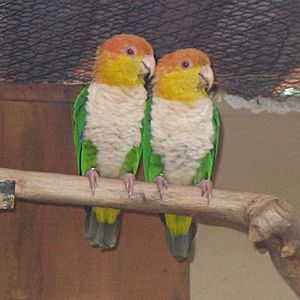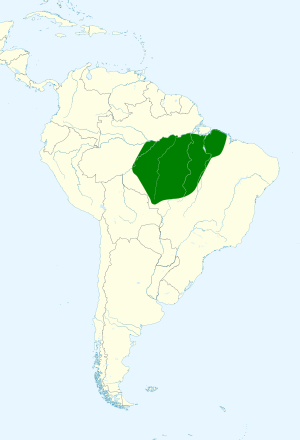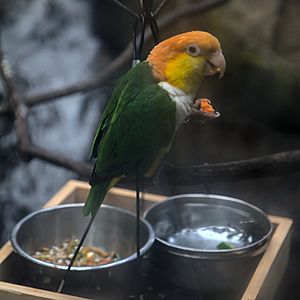White-bellied parrot facts for kids
Quick facts for kids White-bellied parrot |
|
|---|---|
 |
|
| Conservation status | |
| Scientific classification | |
| Genus: |
Pionites
|
| Species: |
leucogaster
|
 |
|
| Range of P. l. leucogaster | |
The white-bellied parrot (Pionites leucogaster) is a colorful bird found in South America. People who keep birds sometimes call it the white-bellied caique. It lives in countries like Bolivia, Brazil, Colombia, and Peru.
Contents
Types of White-bellied Parrots
Scientists group the white-bellied parrot into three main types, called subspecies. These are like different versions of the same bird, each with small differences.
- P. l. xanthomerius (Black-legged parrot)
- P. l. xanthurus (Yellow-tailed parrot)
- P. l. leucogaster (Green-thighed parrot)
Some bird experts, like those who write the Handbook of the Birds of the World, think these three types are actually separate species. They call them the "black-legged," "yellow-tailed," and "green-thighed" parrots. You might also hear them called the "western," "central," and "eastern" white-bellied parrots. The map you see shows where the P. l. leucogaster type lives.
What Do White-bellied Parrots Look Like?
White-bellied parrots are about 23 to 25 centimeters (9 to 10 inches) long. They weigh around 155 grams (5.5 ounces), which is about as much as a small apple. They are chunky birds with short tails. Male and female parrots look the same.
The most common type, P. l. leucogaster, has a mostly yellow head with an orange top and back of the neck. Their upper body is dull green, but their lower back is bright green. Their throat, neck sides, and chest are yellow. The lower part of their chest and their belly are white, and their upper legs have bright green feathers. Their wings are mostly dull green with reddish-orange feathers under their wings and dark blue main flight feathers. Their tail is bright green.
Their beak is a pale, horn-like color, and the skin around their nostrils (called a cere) is bright pink. Their eyes are reddish-brown, and their legs and feet are bright pink. Young parrots look similar to adults but have a brownish top and back of the neck.
Differences in Subspecies
- P. l. xanthomerius has an apricot-orange top and back of the neck. Its upper leg feathers are yellow, and its legs and feet are blackish.
- P. l. xanthurus also has an apricot-orange top and back of the neck and yellow upper leg feathers. But its tail is yellow! Its legs and feet are pink, like the main type.
Sometimes, the white feathers on a white-bellied parrot's chest can look brownish. This might happen because they like to bathe by rubbing their bodies against wet leaves and plants.
Where Do White-bellied Parrots Live?
Each type of white-bellied parrot lives in a slightly different area:
- P. l. xanthomerius lives in eastern Peru, eastern Bolivia, and western Brazil. Since 2011, it has also been seen in a small part of southeastern Colombia.
- P. l. xanthurus lives in Brazil, between the Juruá and Purús rivers, and south to the upper Madeira River area.
- P. l. leucogaster lives in northern Brazil, between the Madeira River and the Atlantic coast.
All three types of white-bellied parrots live in warm, wet tropical forests. They seem to prefer the edges of the forest and open areas, rather than the very thick, closed parts. The P. l. leucogaster type can also be found in smaller numbers in drier forests in the southern parts of its home range.
White-bellied Parrot Behavior
Movement
Scientists don't know much about how white-bellied parrots move around, or if they migrate (travel long distances).
Feeding Habits
We don't know a lot about how these parrots find their food or exactly what they eat. However, we do know they eat fruits from trees and palms, as well as flowers.
Reproduction and Life Cycle
The P. l. leucogaster type of parrot lays its eggs between November and January. The P. l. xanthomerius type is thought to lay eggs between August and December. Both types build their nests in holes inside trees. They usually lay two to four eggs at a time. Not much else is known about how they raise their young. For the P. l. xanthurus type, we assume their breeding habits are similar to the others.
Vocalization
When white-bellied parrots fly, they make a high-pitched, harsh, squealing sound like "sqheee .. sqheee." When they are sitting, they make loud, high-pitched "kree-ee-ee" or "skeeew" noises. They can also make softer, more musical whistles and quiet "kee-ah-u" or "kew" calls.
Conservation Status
The IUCN (International Union for Conservation of Nature) is a group that checks on how well animal populations are doing. They look at each type of white-bellied parrot separately.
The "green-thighed" P. l. leucogaster type was once considered "Endangered," meaning it was in great danger. But since 2021, it's been listed as "Vulnerable." This means it still needs protection, and its numbers are decreasing. It lives in a large area, but its population size isn't known. Its forest home is being lost or damaged, and it might also be hunted.
The "black-legged" P. l. xanthomerius type is listed as "Least Concern." This means it's doing okay for now. Like the "green-thighed" type, it lives in a large area, but its population is also believed to be shrinking. The main threat to this parrot is deforestation, which is when forests are cut down for farming and ranching.
The "yellow-tailed" P. l. xanthurus type is also listed as "Least Concern." It lives in a smaller area than the other two. Its population size is unknown and is also thought to be decreasing. Deforestation for farming and ranching is the biggest danger to this parrot too.
See also
 In Spanish: Caique de cabeza naranja para niños
In Spanish: Caique de cabeza naranja para niños



